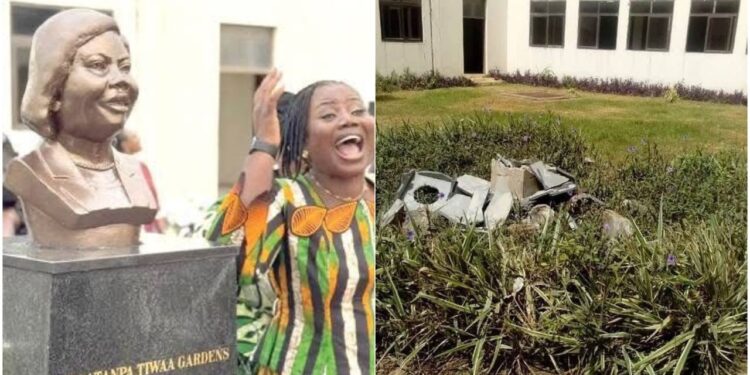According to a report from Ghanaweb. In a shocking incident that has captured the attention of the nation, the statue of Mrs. Maame Yaa Tiwaa Addo-Danquah, the Executive Director of Ghana’s Economic and Organised Crime Office (EOCO), was destroyed mere moments after John Dramani Mahama was sworn in as the President of Ghana. This unexpected event has ignited a firestorm of reactions, with social media inundated with a mix of jubilation and controversy from Ghanaians across the country.
The statue, which had been erected to honor Mrs. Addo-Danquah for her service at EOCO, was reportedly toppled by unidentified individuals in what many speculate to be a symbolic act of protest or a reflection of the political shift following Mahama’s inauguration. The occurrence has reignited discussions regarding her tenure at EOCO and her perceived alignment with the previous administration led by Nana Addo Dankwa Akufo-Addo.
Responses on social media have varied widely, showcasing the deep divides in public opinion. One user expressed their approval, stating, “Good news,” while another remarked, “Good work! Remaining the Akufo-Addo statue at Takoradi Roundabout.” A third comment reflected a desire for accountability, reading, “Waiting for her arrest. Criminality at EOCO is finally over.” These comments highlight the polarized views surrounding Mrs. Addo-Danquah’s leadership and the broader context of Ghanaian politics.
Throughout her tenure at EOCO, Mrs. Addo-Danquah faced scrutiny and criticism, with detractors alleging that her investigations and enforcement actions were politically biased. Critics accused her of disproportionately targeting opposition figures while providing protection to allies of the former government. Conversely, her supporters contend that she executed her responsibilities with professionalism and made meaningful contributions to the fight against economic and organized crime in Ghana.
The destruction of her statue is being interpreted by many as a symbolic rejection of her legacy and an indicator of the charged political atmosphere that has emerged following the change in government. While some view the act as a necessary step toward accountability and justice, others criticize it as an unnecessary and destructive gesture that undermines the respect for public figures and institutions.
This incident raises broader questions about how the legacies of Ghanaian leaders are perceived once they leave office. It also highlights the profound divisions that exist within Ghanaian politics, where even symbols of service can become contentious battlegrounds. The polarization evident in the reactions to this event underscores the challenges facing the nation as it navigates a new political landscape.
As news of the statue’s destruction circulates, many Ghanaians are keenly awaiting official statements from the EOCO, Mrs. Addo-Danquah herself, and the new administration under President Mahama. This incident serves as a stark reminder of the difficulties in fostering national unity and respect for institutions, particularly during times of political transition.
The reactions to this event encapsulate the complexities of Ghana’s political climate, where history, legacy, and public perception intertwine. As the nation moves forward under new leadership, the destruction of Mrs. Addo-Danquah’s statue may serve as a catalyst for broader discussions about accountability, governance, and the role of public figures in shaping the country’s future.










Discussion about this post